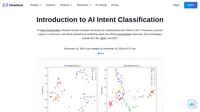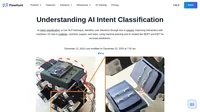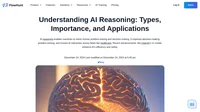Pattern recognition is a computational process that involves identifying patterns and regularities in data. This concept is integral to fields such as computer science, psychology, artificial intelligence (AI), and data analysis. It is used to automate the process of recognizing patterns in data, which can range from speech, text, and images to more abstract data patterns. At its core, pattern recognition is about the classification and interpretation of input data, and it plays a crucial role in the development of intelligent systems that can mimic human cognitive functions.
Types of Pattern Recognition
- Statistical Pattern Recognition: This involves the use of statistical techniques to classify data based on its features. The pattern is viewed as a point in a d-dimensional space, where features are chosen to enable the separation of different patterns. Statistical methods often involve learning models from labeled data, where the system learns to associate specific input patterns with corresponding outputs. Techniques such as Bayesian networks, decision trees, and support vector machines are often employed in this paradigm.
- Syntactic Pattern Recognition: Also known as structural pattern recognition, this method involves recognizing complex patterns by considering their interrelationships and hierarchical structures. It is suitable for data that can be described using grammatical rules. This approach is particularly useful in applications that require an understanding of complex structures, such as language processing and bioinformatics, where patterns are defined more by their structural relationships than by their individual features.
- Neural Network Pattern Recognition: Leveraging artificial neural networks, this method mimics human brain processes to detect patterns. Neural networks are particularly powerful in handling high-dimensional data, making them a popular choice for modern AI applications. Deep learning, a subset of neural networks, involves the use of multiple layers to extract progressively higher-level features from the raw input, enabling sophisticated pattern recognition capabilities in areas such as image and speech recognition.
- Template Matching: One of the earliest methods in pattern recognition, template matching works by comparing data against stored templates to find similarities. It is widely used in image processing for detecting objects based on reference images. This method is straightforward but can be computationally expensive and sensitive to noise and variations in the data, making it less suitable for applications requiring high accuracy and robustness.
Applications of Pattern Recognition
Pattern recognition is a versatile tool used across various domains, including:
- Computer Vision: Used to interpret visual information from the world, enabling features such as facial recognition and object detection. Computer vision systems employ pattern recognition techniques to transform visual data into a form that can be analyzed and understood by machines, allowing for applications in surveillance, autonomous vehicles, and augmented reality.
- Speech Recognition: Converts spoken language into text by identifying and interpreting sound patterns. This technology is foundational to voice-activated assistants, enabling machines to understand and respond to human speech in real time. Pattern recognition in speech involves analyzing sound wave patterns and mapping them to corresponding phonetic structures.
- Optical Character Recognition (OCR): Translates images of text into machine-readable text, used in digitizing printed documents. OCR systems utilize pattern recognition to identify and convert various fonts and handwriting styles into digital text, facilitating data entry automation and information retrieval.
- Medical Imaging: Assists in diagnosing diseases by identifying patterns in medical images such as MRI or CT scans. Pattern recognition in this context enables the detection of abnormalities and the classification of medical conditions, contributing to more accurate and timely diagnoses.
- Data Analysis: Helps in detecting trends and anomalies in datasets, facilitating better decision-making. In fields such as finance and marketing, pattern recognition is used to analyze consumer behavior, forecast market trends, and identify fraudulent activities by examining transaction patterns.
Examples and Use Cases
- Facial Recognition Systems: Utilize pattern recognition to identify individuals based on facial features. This technology is prevalent in security systems and mobile devices for authentication. By analyzing facial landmarks and comparing them to a database of known faces, these systems can accurately verify identities.
- Autonomous Vehicles: Employ computer vision and pattern recognition to detect and interpret road signs, signals, and obstacles. These systems rely on pattern recognition to navigate complex environments and make real-time decisions, enhancing the safety and efficiency of self-driving cars.
- Financial Fraud Detection: Analyzes transaction patterns to detect fraudulent activities in financial systems. By recognizing unusual patterns in transaction data, such systems can alert authorities to potential fraud, helping to prevent financial losses.
- Marketing and Customer Insights: Uses pattern recognition to segment customers based on purchasing behavior and predict future buying trends. By analyzing consumer data, companies can tailor marketing strategies and enhance customer experiences, driving sales and customer satisfaction.
Pattern Recognition in AI and Machine Learning
Pattern recognition is a cornerstone of AI and machine learning, providing machines with the ability to learn from data. In AI, pattern recognition enables systems to perform tasks such as classification, clustering, and predictions without explicit programming. Machine learning models, such as neural networks, use pattern recognition to learn from vast amounts of data, identifying complex patterns and making decisions based on those patterns. This capability is the driving force behind advancements in AI technologies, including deep learning and natural language processing, enabling machines to understand and interact with the world more intelligently.
Challenges in Pattern Recognition
- Data Quality: Accurate pattern recognition requires high-quality data. Noisy or incomplete data can lead to incorrect interpretations. Ensuring data integrity and preprocessing data to remove noise and inconsistencies are critical steps in the pattern recognition process.
- Computational Complexity: Some pattern recognition tasks, especially involving large datasets or complex patterns, can be computationally intensive. Optimizing algorithms and leveraging advanced computing resources, such as GPUs and cloud computing, can help manage computational demands.
- Overfitting: In machine learning, models may become too tailored to the training data, losing their ability to generalize to new data. Techniques such as cross-validation, regularization, and pruning can help mitigate overfitting, ensuring models remain robust and applicable to unseen data.
Pattern Recognition in Technology and Society
Pattern recognition is a field of study integral to various technological and societal applications, involving the identification and categorization of patterns in data. One significant area of pattern recognition is facial recognition, as explored in the paper “Responsible Facial Recognition and Beyond” by Yi Zeng et al. (2019). This paper discusses the dual aspects of facial recognition technology, including potential risks and societal concerns. It highlights current policies and regulations across different countries and emphasizes that the risks are not limited to facial recognition but extend to other biometric technologies like gait, iris, and voice recognition. The authors advocate for technological advancements to ensure these systems develop for social good. Read more
In the realm of network management, pattern recognition methods have shown promise, as discussed in “Developing Intellectual Network Management Facilities by Means of Pattern Recognition Theory” by Yuriy A. Chashkov (2004). This work delves into how pattern recognition can aid in identifying the state of network equipment, enhancing the efficiency and reliability of network management systems. Read more
Furthermore, the paper “Towards Robust Pattern Recognition: A Review” by Xu-Yao Zhang et al. (2020) addresses the challenges of achieving robustness in pattern recognition systems. Despite high accuracy levels, these systems often falter in dynamic, real-world environments due to their reliance on three basic assumptions: closed-world, independent and identically distributed data, and clean and large datasets. The paper reviews the progress in this field and suggests that future research should focus on overcoming these limitations, drawing inspiration from the human brain’s ability to learn and adapt in diverse and changing conditions. Read more
Introduction to AI Intent Classification
Discover how AI Intent Classification enhances interactions, boosts user satisfaction, and streamlines business operations across various sectors.
Understanding AI Intent Classification
Unlock the potential of AI intent classification with FlowHunt. Enhance chatbot efficiency, customer support, and user experience today!
PathAI Review: AI Revolutionizing Pathology
Revolutionize pathology with PathAI's AI-powered solutions. Enhance diagnostic accuracy, streamline workflows, and accelerate drug development."
Understanding AI Reasoning: Types, Importance, and Applications
Explore AI reasoning types, importance, and applications in healthcare and beyond. Discover how AI enhances decision-making and innovation.



